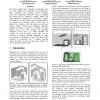TMI
2011
14 years 22 days ago
2011
—We consider 3D brain structures as continuous parameterized surfaces and present a metric for their comparisons that is invariant to the way they are parameterized. Past compari...
ICRA
2010
IEEE
14 years 3 months ago
2010
IEEE
We present a novel approach for unsupervised discovery of repetitive objects from 3D point clouds. Our method assumes that objects are geometrically consistent, and uses multiple o...
ICRA
2010
IEEE
14 years 4 months ago
2010
IEEE
— Scan matching techniques have been widely used to compute the displacement of robots. This estimate is part of many algorithms addressing navigation and mapping. This paper add...
PAMI
2002
14 years 5 months ago
2002
This paper investigates the use of Euclidean invariant features in a generalization of iterative closest point registration of range images. Pointwisecorrespondences are chosen as...
CAGD
2004
14 years 5 months ago
2004
We consider the ICP (iterative closest point) algorithm, which may in general be used for moving `active' elements such as curves and surfaces towards geometric objects whose...
3DIM
2001
IEEE
14 years 9 months ago
2001
IEEE
The ICP (Iterative Closest Point) algorithm is widely used for geometric alignment of three-dimensional models when an initial estimate of the relative pose is known. Many variant...
3DIM
2001
IEEE
14 years 9 months ago
2001
IEEE
A novel solution is presented to the Nearest Neighbor Problem that is specifically tailored for determining correspondences within the Iterative Closest Point Algorithm. The refer...
CGI
2004
IEEE
14 years 9 months ago
2004
IEEE
This paper presents a powerful variant of the ICP (Iterative Closest Point) algorithm for registering range images using a probability field. The probability field (p-field) repre...
CAIP
1997
Springer
14 years 10 months ago
1997
Springer
Abstract—This work presents a method for the registration of threedimensional (3-D) shapes. The method is based on the iterative closest point (ICP) algorithm and improves it thr...
ICRA
2000
IEEE
14 years 10 months ago
2000
IEEE
The need to register data is abundant in applications such as: world modeling, part inspection and manufacturing, object recognition, pose estimation, robotic navigation, and reve...




